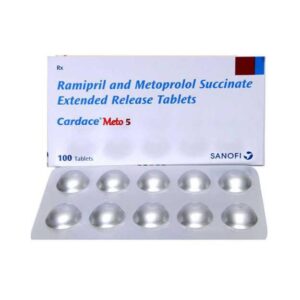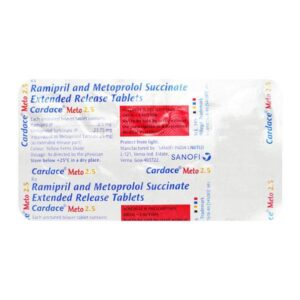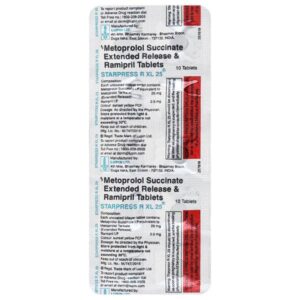RAMIPRIL + METOPROLOL
Ramipril: Ramipril is a medication belonging to the class of drugs known as angiotensin-converting enzyme (ACE) inhibitors. It is primarily used to treat high blood pressure (hypertension) and heart failure. Additionally, ramipril may be prescribed to reduce the risk of heart attack, stroke, and other cardiovascular events in patients who have a history of heart disease or who are at high risk for it.
The mechanism of action of ramipril involves inhibiting the activity of the ACE enzyme responsible for producing angiotensin II. Angiotensin II is a potent vasoconstrictor (narrows blood vessels) and also stimulates the release of aldosterone, a hormone that causes fluid retention. By blocking the production of angiotensin II, ramipril helps relax and widen blood vessels, reducing blood pressure and improving blood flow. It also helps decrease the workload on the heart by reducing fluid retention.
The starting dose of ramipril for hypertension is typically 2.5 mg once daily. The dose may be increased gradually, up to a maximum of 10 mg daily, based on the individual patient’s response. For heart failure, the starting dose is usually 1.25 mg once daily and can be increased to a maximum of 10 mg daily.
Like any medication, ramipril can cause side effects. Common side effects may include dizziness, cough, fatigue, headache, and gastrointestinal disturbances (such as nausea, vomiting, or diarrhea). Some patients may experience a decrease in blood pressure, especially when starting or increasing the dose. Rare but serious side effects can include angioedema (swelling of the face, lips, tongue, or throat), liver problems, and kidney problems. It is important to seek medical attention if any of these serious side effects occur.
As with any medication, it is essential to follow the prescribed dosage and consult with a healthcare professional for any concerns or questions about the drug and its potential side effects.
Metoprolol: Metoprolol is a medication used to treat high blood pressure, angina (chest pain), and heart failure. It belongs to a class of drugs called beta-blockers, which work by blocking the action of certain natural substances in the body, such as adrenaline. By blocking these substances, metoprolol helps to slow down the heart rate, reduce blood pressure, and decrease the workload on the heart.
The dose of metoprolol can vary depending on the condition being treated. For high blood pressure, the typical starting dose is 50 milligrams taken twice a day. The dose may be increased gradually if needed. For angina, the usual dose is 50-100 milligrams taken twice a day. In heart failure, the initial dose is usually 12.5-25 milligrams taken once daily, and the dose may be increased gradually every 2 weeks.
As with any medication, metoprolol can cause side effects. Common side effects include dizziness, fatigue, low blood pressure, slow heartbeat, and gastrointestinal disturbances such as nausea and diarrhea. Some people may experience cold hands and feet, difficulty sleeping, or vivid dreams. It is important to note that not everyone will experience these side effects, and some individuals may experience different or more severe side effects.
Rare but serious side effects of metoprolol can include shortness of breath, wheezing, sudden weight gain, swelling of the ankles/feet, and fainting. These symptoms may indicate a serious allergic reaction or worsening heart failure and should be reported to a healthcare professional immediately.
It is essential to take metoprolol exactly as prescribed by a doctor and to follow any dietary or exercise recommendations. Suddenly stopping metoprolol can cause a rapid increase in heart rate and blood pressure, so it is important to gradually decrease the dose under medical supervision when discontinuing the medication.
Overall, metoprolol is a commonly prescribed beta-blocker with a well-established effectiveness in treating various cardiovascular conditions. However, it is essential to discuss any concerns or questions about medication use and potential side effects with a healthcare provider.









